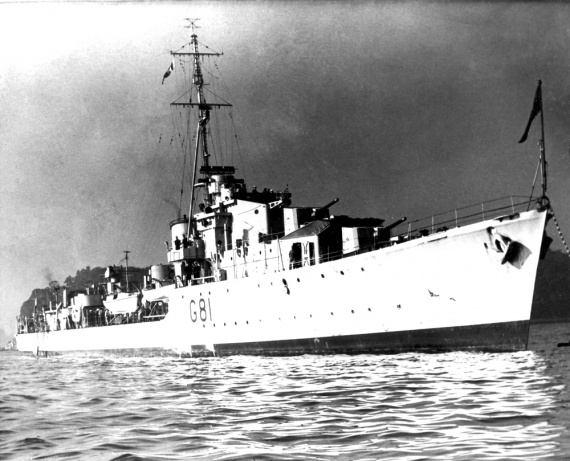HMAS Quiberon at sea.
At the end of January 1943 Quiberon left the Mediterranean as a unit of the escort of a convoy bound from England to Capetown. It arrived at Durban on 27 February and from there proceeded to Australia, arriving at Fremantle on 29 March, having steamed 51 000 miles on war service.
After refitting at Melbourne, it returned to the Indian Ocean and at Kilindini, Kenya, in June 1943 joined the British Eastern Fleet. It spent the remainder of 1943 almost constantly at sea escorting Indian Ocean convoys.
In 1944 Quiberon continued serving as an escort destroyer of the Eastern Fleet protecting convoys proceeding mainly between India and Aden. In March 1944, British Indian Ocean naval forces were reinforced, and were able to take the offensive against Japanese held territory. Quiberon took part in the carrier air strikes against Sabang in April 1944 and Sourabaya in May 1944, before returning to Australia for another refit at Melbourne.
Quiberon rejoined the Eastern Fleet at Trincomalee, Ceylon, on 1 August 1944 and resumed escort duty in the Indian Ocean. In October 1944 it took part in a series of fleet bombardments of the Japanese held Nicobar Islands. In mid-December it detached from the Eastern Fleet and returned to Australia, where for the next few weeks it operated as an escort and anti-submarine vessel on the Australia Station.
In March 1945 Quiberon proceeded to Manus, the United States base in the Admiralty Islands, as a unit of the British Pacific Fleet. From Manus it proceeded north to the operational area and was thereafter until the end of hostilities actively engaged in the closing phases of the war at sea against Japan. It took part in operations in support of the American seizure of Okinawa and subsequent attacks on the Japanese homeland. When the war ended in August, it had steamed 236 000 miles on war service.
Peace did not bring immediate respite for Quiberon. It was present at the re-occupation of Shanghai, and then served in the East Indies until February 1946, troop carrying, retrieving prisoners of war and assisting in the re-establishment of Dutch control in the area.
In March 1946, following a short refit at Sydney, it sailed for Japan to begin the first of 3 periods of occupation duty. It reached Sydney at the end of its third period of Southeast Asia service on 22 July 1948 and was there immobilised, having steamed 80 000 miles in the postwar years and a total of 316 772 miles since commissioning. In 6 years of seagoing service Quiberon had been under way for 20 452 hours, or almost 2 and a half years. It paid off on 15 May 1950.
In November 1950 the task of converting Quiberon to a modern fast anti-submarine frigate was commenced at Cockatoo Island Dockyard in Sydney. Later the ship was transferred to the Naval Dockyard at Garden Island, Sydney, where the conversion was completed in December 1957.
Quiberon recommissioned on 18 December 1957 as a unit of the 1st Frigate Squadron. When completed by the conversion of 3 ships of the same class from destroyers to frigates, the Squadron comprised HMA Ships Quadrant, Queenborough, Quiberon and Quickmatch.
During the following 6 and a half years, Quiberon spent several periods of duty on Southeast Asia service as a unit of the Commonwealth Strategic Reserve and from time to time operated as a unit of the Southeast Asia Treaty Organisation forces on periodical exercises in Southeast Asian waters. Otherwise it operated as a unit of the Australian Fleet on the Australia Station. Its service career ended when it paid off to Reserve on 26 June 1964.
Quiberon was sold on 15 February 1972 for breaking up to Fujita Salvage Company Limited of Osaka, Japan, for $68 260. On 10 April 1972 the Japanese tug Sumi Maru No 38 left Sydney for Japan with Quiberon and another former RAN vessel, Tobruk (I), in tow.

